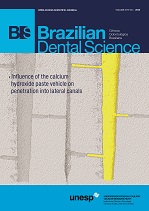Comparative analysis of different prophylatic methods on primary teeth enamel roughness
DOI:
https://doi.org/10.14295/bds.2018.v21i3.1567Abstract
Objective: The purpose of this study was to perform an experimental quantitative comparison of primary teeth enamel alterations under three commonly prophylaxis surface polishing treatments. Material and Methods: 36 healthy primary teeth naturally exfoliated were selected and randomly separated in three groups. Group I was treated with a rotary instrument set at a low speed, rubber cup and a mixture of water and pumice; group II with a rotary instrument set at a low speed, rubber cup and prophylaxis paste Herjos-F (Vigodent S/A Indústria e Comércio, Rio de Janeiro, Brazil); and group III with sodium bicarbonate spray Profi II Ceramic (Dabi Atlante Indústrias Médico Odontológicas Ltda, Ribeirão Preto, Brazil). All procedures were performed by the same operator for ten seconds, and samples were rinsed and stored in distilled water. Pre-and post-treatment surface evaluation was completed using a surface profilometer Mitutoyo SJ400. Results: The results of this study were statistically analyzed with the GraphPad PRISM (version 6, 2010). The pumice and water led to significantly rougher surfaces than other groups in Tukey’s test (Group I: 1.22 Ra; Group II 0.38 Ra; Group III: 1.01 Ra). Pre-and post-treatment comparison revealed significantly rougher enamel surface with pumice. Conclusion: Based on this study, it can be concluded that there was an increased enamel surface roughness when teeth were treated with pumice and water in comparison to bicarbonate spray and prophylaxis paste.
Keywords
Dental enamel; Dental prophylaxis; Jet abrasive system; Enamel roughness; Primary teeth.
Downloads
Downloads
Published
How to Cite
Issue
Section
License
Brazilian Dental Science uses the Creative Commons (CC-BY 4.0) license, thus preserving the integrity of articles in an open access environment. The journal allows the author to retain publishing rights without restrictions.
=================




























